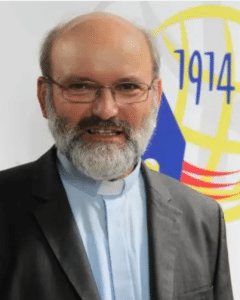Father Heinrich Walter delves into the spirit of synodality in Schoenstatt from the founder’s perception and integrates it into Pope Francis’ vision of synodality.
“The topic of synodality is not a mere chapter in a dissertation on ecclesiology, nor a fad, a slogan or the new term to be used or a tool for our meetings. Synodality expresses the nature of the Church, its form, its style, its mission. And that is why we speak of the synodal Church.” [1]
With this message Pope Francis describes the path that the Church begins starting this year 2021 continuing until 2023, the path of synodality. The Pope’s desire is that everyone be heard and participate, in a process of “encounter, listening and discernment”.
The Schoenstatt Movement is also part of this synodal process. We talked about this in an interview with Father Heinrich Walter, from Schoenstatt International:
How do you think synodality occurs within the structure of our Schoenstatt Movement? When we consider the national presidencies and the general presidency, can we consider them synodal? Why?
Father Heinrich Walter – First of all, we must ask ourselves how we come to understand the synodal way. Pope Francis understands synodality as “what God expects of the Church in the third millennium” (October 18, 2015).
The Church is a flock following Jesus, that is, a community on a journey including the bishops and all the faithful. Therefore, synodality must not occur only among the bishops, but among all of God’s people.
Therefore, the synodal process begins in the dioceses and parishes. Synodality is a style and an attitude by which the Church wants to fulfill its mission in the world. Schoenstatt is part of this community on the go and participates in the processes in dioceses and in the universal Church.
Father Kentenich embraced Vatican II’s self-understanding of the Church as the People of God; he spoke quite often, after the Council and until his death, of the pilgrim Church and also of a humble, poor, Marian Church, guided by the Holy Spirit.
We understand Schoenstatt as a spiritual family composed of many communities and branches. We speak of the Schoenstatt Movement in terms of the common apostolate we carry out in the Church through the strength of our charism. The task of the presidencies – national and worldwide – is related to the Family’s solidarity and the accurate interpretation of the Founder’s charism.
The task of the National Central Committee is to take care, within a country, of the inspiration of the Movement and the centralization of life. The particular organization of the local apostolate is in the hands of those responsible for each diocese. Therefore, it is not so easy to compare these committees with the concept of synodality.
Synodal spirit in Schoenstatt
However, we can speak of a synodal spirit in Schoenstatt. Each community is independent but must remain in solidarity with all the others on a large scale. Our committees do not have presidents with official authority, like the bishops do in the dioceses. Decisions are taken unanimously, as far as possible.
In the Church, the bishop of the diocese is the one who always decides, and at the World Synod, the Pope decides after all deliberations. The Church ultimately acts through the authority of the hierarchy; thus far, the laity only act in a consultative way. In Schoenstatt we understand exercising leadership with a precaution: it must be done with authority in principle, but democratically when applied.
Did Father Kentenich want everyone to have a voice when he developed this model of organization? Are we faithful to what our founder thought about the structure of Schoenstatt?
Father Heinrich Walter – Father Kentenich always understood that the Schoenstatt organization is at the service of the living organism of our Movement. The spirit and life of the Schoenstatt Family was his main concern: “To relate form and spirit in such a way that spirit and life are always the great forces that dominate everything.” [2]
Thus, he understood leadership as a selfless service to life. “The extent to which an idea arises from the needs and longings of the community and is kept when considering implementation depends greatly on its leadership.” Father Kentenich was a great teacher of this concept. Today we should always strive together to practice this style of leadership and guidance. We need to pay attention to each other, a humble attitude of prayer, a deep knowledge of the Schoenstatt charism and a heroic love amongst us.
The leaders must always be in contact with the life-bearers of the branches and communities. In this sense, everyone has a voice and should be taken seriously, but not in a parliamentary style, where the majority decides. Pope Francis describes a similar attitude: “A synodal Church is a listening Church. It is a mutual listening in which everyone has something to learn. Each one should listen to the others, and everyone should listen to the Holy Spirit to be able to discern what he is saying to the churches” (October 17, 2015).

How can Schoenstatt contribute to the Church from this structure, formed by autonomous communities, and at the same time seeking to walk in unity?
Father Heinrich Walter: I have thought about this many times. First of all, it is all about working in the heart of the Church from the strength of the Covenant of Love. It is imperative to have a great love for the Church. Synodality can only be fruitful in the Church if there are many life-bearers who, with a true Christian spirit, work with trust and co-responsibility.
This involves individuals as well as communities and movements.
A Church led in a synodal manner needs great nurturing of the spirit so that the decentralized life of the churches may be inspired by a deep inner motivation. This has to do with the spirit of conversion and the missionary transformation of the Church, as spoken by Pope Francis.
A powerful nurturing of the spirit is essential
I am also thinking here of the great impact that the Pilgrim Mother has among you in Brazil. The more freedom there is in the different cultural environments, the stronger the currents of life and the processes of common life in the Church must be. We call this nurturing of the spirit. Only with a powerful nurturing of the spirit can St. Paul’s vision of a body with many members and the one Spirit with many different gifts take contemporary shape.
Today we also speak of a reconciled diversity. I see the work of a broad nurturing of the spirit as a crucial contribution of Schoenstatt to the future of the Church.
How and in what ways do you think we can we improve synodality in Schoenstatt?
Father Heinrich Walter – In the context of synodality, Pope Francis speaks often about listening, listening to each other, listening also to the Holy Spirit. Father Kentenich speaks frequently about freedom and a Church governed by the Holy Spirit. He chose the way of the federative union for Schoenstatt because he relied on the synergy that arises from the free interaction within a family. With this he wanted to bring about a great vitality and fruitfulness. There is still room for further growth in this area.
Life is rekindled through life
Among our communities we should place less emphasis on our own environments and be even more interested in the life and work of other branches and communities. Often, we only know what our own branch or community is doing. Life is rekindled through life, Father Kentenich used to say. This can also take place if we become interested and seek information and testimonies from other countries and cultures. We could make this richness more visible and rejoice together throughout the world.
This could be done through magazines, media events and social media. I am glad to see that a lot is happening through encounters and initiatives between our branches, also at the international level. An important role is being played by the younger generation, who wants to get to know the whole world. They are excellent ambassadors of life between countries and cultures.
Source: schoenstatt.org.br
[1] Pope Francis address to the faithful of the Diocese of Rome. Paul VI Hall. Saturday, September 18, 2021
[2] The secret of Schoenstatt’s vitality, part 1. Spirit and form. Joseph Kentenich. Editorial Nueva Patris, March 2011, page 75.
